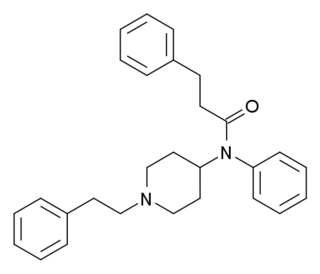
4-Phenylfentanyl is an opioid analgesic that is a derivative of fentanyl. It was developed during the course of research that ultimately resulted in super-potent opioid derivatives such as carfentanil, though it is a substantially less potent analogue. 4-Phenylfentanyl is around eight times the potency of fentanyl in analgesic tests on animals, but more complex 4-heteroaryl derivatives such as substituted thiophenes and thiazoles are more potent still, as they are closer bioisosteres to the 4-carbomethoxy group of carfentanil.

R-30490 is an opioid analgesic related to the highly potent animal tranquilizer carfentanil, and with only slightly lower potency. It was first synthesised by a team of chemists at Janssen Pharmaceutica led by Paul Janssen, who were investigating the structure-activity relationships of the fentanyl family of drugs. R-30490 was found to be the most selective agonist for the μ-opioid receptor out of all the fentanyl analogues tested, but it has never been introduced for medical use in humans, although the closely related drug sufentanil is widely used for analgesia and anesthesia during major surgery.

Butyrfentanyl or butyrylfentanyl is a potent short-acting synthetic opioid analgesic drug. It is an analog of fentanyl with around one quarter of its potency. One of the first mentions of this drug can be found in document written by The College on Problem of Drug Dependence, where it is mentioned as N-butyramide fentanyl analog. This document also states that the article describing its clinical effects was published in 1987. It is an agonist for the μ-opioid receptors.

Benzylfentanyl (R-4129) is a fentanyl analog. It was temporarily placed in the US Schedule I by emergency scheduling in 1985 due to concerns about its potential for abuse as a designer drug, but this placement was allowed to expire and benzylfentanyl was formally removed from controlled substance listing in 2010, after the DEA's testing determined it to be "essentially inactive" as an opioid. Benzylfentanyl has a Ki of 213 nM at the mu opioid receptor, binding around 1/200 as strong as fentanyl itself, though it is still slightly more potent than codeine.

Furanylfentanyl (Fu-F) is an opioid analgesic that is an analog of fentanyl and has been sold as a designer drug. It has an ED50 value of 0.02 mg/kg in mice. This makes it approximately one fifth as potent as fentanyl.

Acrylfentanyl (also known as acryloylfentanyl or Egyptenyl) is a highly potent opioid analgesic that is an analog of fentanyl and has been sold online as a designer drug. In animal studies the IC50 or half maximal inhibitory concentration for acrylfentanyl to displace naloxone is 1.4 nM, being slightly more potent than fentanyl itself (1.6 nM) as well as having a longer duration of action.

Methoxyacetylfentanyl, commonly known as MAF is an opioid analgesic that is an analog of fentanyl and has been sold online as a designer drug.

Tetrahydrofuranylfentanyl is an opioid analgesic that is an analog of fentanyl and has been sold online as a designer drug, first appearing in Europe in late 2016.

Orthofluorofentanyl is an opioid analgesic that is an analog of fentanyl and has been sold online as a designer drug. While the structural isomer p-fluorofentanyl was one of the first illicit fentanyl analogues identified in 1981, Orthofluorofentanyl did not appear on the illicit market until August 2016.

Cyclopentylfentanyl is an opioid analgesic that is an analog of fentanyl and has been sold online as a designer drug, mainly in Sweden and other Scandinavian countries.

Valerylfentanyl is an opioid analgesic that is an analog of fentanyl and has been sold online as a designer drug. It has been seldom reported on illicit markets and there is little information about it, though it is believed to be less potent than butyrfentanyl but more potent than benzylfentanyl. In one study, it fully substituted for oxycodone and produced antinociception and oxycodone-like discriminative stimulus effects comparable in potency to morphine in mice, but failed to stimulate locomotor activity in mice at doses up to 100 mg/kg.

4-Chloroisobutyrylfentanyl is an opioid analgesic that is an analog of fentanyl, and has been sold online as a designer drug.

Cyclopropylfentanyl is an opioid analgesic that is an analog of fentanyl and has been sold as a designer drug. Between June and December 2017, a total of 78 cyclopropylfentanyl-related deaths with analytical confirmation in post-mortem samples were reported by various European countries. Another 115 deaths involving cyclopropylfentanyl were reported from the United States in 2017.

Tetramethylcyclopropylfentanyl is an opioid analgesic that is an analog of fentanyl and has been sold as a designer drug.

Benzodioxolefentanyl is an opioid analgesic that is an analog of fentanyl and has been sold as a designer drug.

3-Phenylpropanoylfentanyl (β'-phenylfentanyl) is an opioid analgesic that is an analog of fentanyl, which was invented in 1981, and has been sold as a designer drug, first identified in March 2017 in Sweden.

4-Methylphenethylacetylfentanyl is an opioid analgesic that is an analog of fentanyl and has been sold as a designer drug.

Isofentanyl (3-methyl-benzylfentanyl) is an opioid analgesic that is an analog of fentanyl first invented in 1973, and which has been sold as a designer drug.

2,2'-Difluorofentanyl is an opioid analgesic that is an analog of fentanyl which has been sold as a designer drug.




















